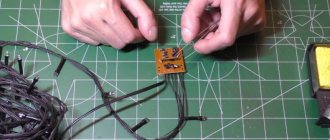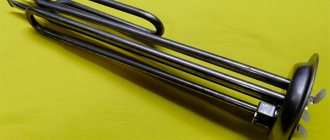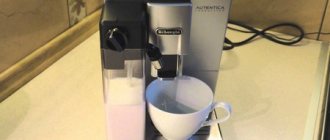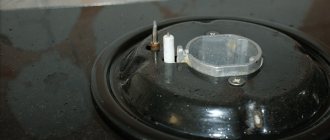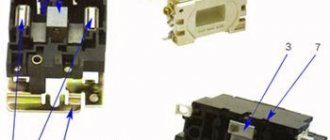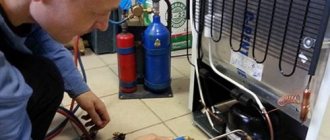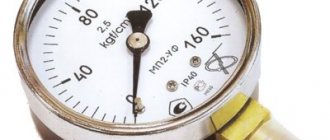Do-it-yourself repair of Saeco coffee machines is difficult because the body is non-separable. The lid is removed from above, the master unscrews a bunch of screws... the insides of the heavy unit are pulled up. The procedure is tedious, experienced repairmen help with a screwdriver, the authors simply pretend that the action is not easy. The review will first consider the principle of operation, the features of Saeco Vienna coffee machines, then the procedure for disassembling the units, and finally we will say a few words regarding the internal design. After reading the first two sections, you won’t need the third; the mechanics and electrical parts are free of complications.
Water is leaking from under the horn
If you find that the coffee machine is leaking at the junction of the horn and the body, this is not a very serious malfunction that can be easily repaired with your own hands. Most likely, water is flowing due to the fact that the sealing ring at the junction of the so-called “spout” and the body of the coffee machine is clogged. Clogging can occur due to anything: fat deposits, wet pulp, coffee, foreign objects, etc. In this case, to repair you only need to wash the contaminated area and reassemble the horn.
If the coffee machine is leaking because the seal is damaged (cracked or torn), you need to replace it with a new one. Here you should draw your attention to the fact that it is necessary to replace the o-ring with one with exactly the same characteristics. If you simply find a similar shaped seal in your home workshop (for example, from a car part), you don’t need to install it, because the rubber from which such a product can be made may not be sufficiently resistant to temperatures or not so elastic. The same requirement applies to other consumables!
How to fix a leak yourself
We also draw your attention to the fact that when repairing a coffee machine like this yourself, you need to check the filter of the horn before installing a new seal. Perhaps the filter is clogged with coffee deposits and the breakdown occurred due to the fact that water under pressure was looking for a weak point of breakthrough. If the filter is not cleaned on time, more serious problems may occur.
By analogy, you can repair or replace any other oil seal that is leaking. Did you see water running out of the coffee machine? Don't be afraid to repair the problem area yourself. The main thing is to do this in time, before the water reaches the wiring and electronic unit. Timely repairs can protect you from electric shock and your equipment from complete failure. It should also be noted that the opposite situation - when the coffee machine does not pump water, can occur due to a malfunction of the piston located above the brewer. You can also try to repair it yourself after a visual inspection.
The brew group does not eject
The brewing unit is in the wrong position.
- Turn off the device and wait until it turns off completely (up to 30 seconds).
- Turn on the machine, wait 30 seconds and remove the coffee grounds container and drip tray.
- Try to remove the brewing unit again.
If problems arise in the operation of the Saeko coffee machine, first carefully study the instruction manual and try to find tips for eliminating defects.
If you can’t fix the breakdown or error without the help of others, then call tel. and our experienced craftsmen will repair your SAECO coffee machine in the shortest possible time!
MULTISERVICE.
There was noise from inside, the pressure from the horn decreased
If you notice that the water from the coffee machine is flowing poorly and at the same time there is an extraneous whistle or noise, it means that the mesh or the filter itself in the horn is most likely clogged. It won’t be difficult to wash it, not to mention that such repairs won’t take much time. Special products are sold for cleaning coffee machines or coffee makers from grease. You can also carefully remove debris with a toothpick. The main thing is that when repairing a coffee machine on your own, do not scratch the internal containers, as even small scratches will retain the ground coffee, which contributes to the rapid clogging of the equipment.
If the coffee machine is noisy and does not pour coffee well, it may even be because the filter is clogged due to the coffee beans being ground too strongly. Start the repair by opening the container with coffee beans and checking the grind size. If you see coffee dust, adjust the grind size manually (many coffee machines have this function). Well, the last reason for extraneous noise is wear of the internal pump mechanism, as a result of which the coffee machine makes noise, hums and does not pour water well. In this case, the weak pressure can only be repaired by replacing the pump.
What to do if the coffee flows weakly from the cone
The coffee machine is noisy + water flows weakly
If the water from the machine does not flow well and noise is heard, the mesh is clogged or the filter of the horn is clogged. All you need to do is clean. There are special products on sale that can be used to clean grease from coffee machines.
You can also remove debris with regular toothpicks. If you choose this method, be careful not to scratch the parts.
The Philips coffee machine has another malfunction: it pours coffee poorly and is also noisy, but the reason is that the beans are ground too heavily. To fix this, you need to open the container with grain and make sure that the grind is really coarse.
If there is dust, select a different grain grind manually on the control panel.
Excessive noise can also occur due to a pump malfunction. Replacing the part will help.
Extraneous noise + complete lack of work
If your coffee machine is noisy and does not brew coffee, then you need to independently find the cause of the breakdown. First of all, determine whether the water is heated and supplied in a heated state. If the coffee machine takes water and heats it, but does not dispense coffee, most likely the cause of the breakdown is the formation of an air lock. In this case, the repair boils down to running hot water through the cappuccino maker, which should fix the problem. If coffee flows from the spout in a weak stream, try rinsing the entire system with a special detergent, because... all symptoms indicate clogged pipes. Didn't that help either? It is better to take a non-working coffee machine to a service center, because... there has already been an electronic breakdown, the repair of which is unlikely to be possible for you.
By the way, the electronic unit must independently signal that the system is clogged by displaying an error or an exclamation mark on the display (this should be described in the operating instructions). Sometimes the error may not light up because the corresponding sensor is faulty, which needs to be checked and, if necessary, replaced!
The hot water spout is clogged (for coffee machines with a Panarello/classic cappuccino maker)
If the hot water spout is clogged, remove the outer part of the panarello/classic cappuccino maker and check whether the spout is clogged with scale (white particles in or around the spout).
If there is scale, remove it with a descaling agent.
If these solutions do not resolve the issue, please contact us for further assistance.
The information on this page applies to models: SM6480/00, SM6585/00, EP1223/00, EP2224/40, EP4343/70, EP5447/90, EP4349/70, EP1222/00, EP1224/00, EP2220/10, EP32 46/ 70, EP3241/50, EP2230/10, EP2221/40, EP2231/40, EP2235/40, EP3243/50, EP5310/10, EP5330/10, EP5310/20, EP5335/10, SM5479/10 EP5334/10 EP5365/10, EP5363/10, EP5361/10, SM5473/10, SM5570/10, EP3510/00, EP3519/00, EP3559/00, EP5360/10, EP3363/10, EP4010/00, SM7 580/00, SM7685/ 00, SM7581/00, HD8650/09, HD8914/09, HD8827/09, HD8829/09, HD8919/59, HD8654/59, HD8916/09, HD8928/09, HD8887/19, HD8889/19, HD8888/19 , HD8975/01, HD8648/01, HD8653/41, HD8653/01, HD8649/51, HD8649/11, HD8649/01, HD8822/09, HD8848/09, HD8842/09, HD8828/09, HD8826/09, HD882 5/ 09, HD8912/09, HD8918/09, HD8642/01, HD8644/01, HD8969/09, HD8865/09, HD8885/09, HD8664/09, HD8665/09, HD8646/01, HD8762/19, HD8881/09 , HD8964/01, HD8966/01, HD8763/09, HD8767/01, HD8766/09, HD8768/09, HD8761/09, HD8769/19, HD8769/09, HD8762/01, HD8953/09, HD8954/09, HD885 5/ 09, HD8857/09, HD8754/19, HD8750/99, HD8750/19, HD8852/09, HD8752/89, HD8753/89, HD8753/19, HD8751/19, HD8752/49, HD8942/19, RI9913/06 , RI9914/01, HD8743/19, RI9702/01, HD8745/09, HD8745/19, HD8747/09, HD8833/19, HD8833/39, HD8836/19, HD8836/29, HD8837/09, HD8838/09, HD8 838/ 32, HD8854/09, HD8856/09, HD8943/19, HD8943/29, HD8944/09, HD8946/09, RI9305/01, RI9305/11, RI9752/11, RI9829/11, RI9826/11, RI97 57/01, RI9755/11, RI9833/61, RI9828/11, RI9701/01. Click here to show more product numbers Click here to show fewer product numbers
Buttons don't work
If the coffee machine does not respond to pressing buttons or other possible commands, there may be several reasons for the malfunction. First, check that there is water and coffee in the appropriate containers, because... Most modern coffee machines will not turn on in the “idle” position. Secondly, look closely at the display, which may immediately indicate a certain error. After a visual inspection, you can move on to more serious repairs - remove the front panel and use a multimeter to test all the buttons for power. We have already told you how to use a multimeter.
Sometimes the buttons do not work because coffee was poured on them before and now they are stuck. You can remove sticky dirt with a cotton swab dipped in alcohol. We've done everything, but you still can't set up the buttons on the coffee machine? It is better to contact specialists, because... The problem may lie in a malfunction of the electronic control unit, and in this case, repairing a coffee machine is much more difficult. For those who are “friends” with the tester and know how to check the integrity of the circuit, we advise you to sequentially check all the elements of the circuit. Perhaps the coffee machine is not working because the fuse has blown or some resistor has failed. Replacing a broken component on a board is not difficult if you know how to do it.
Self-repair of coffee machines, tips, tricks
If a coffee machine breaks down, in some cases you can, by and large, figure it out on your own; to do this, you don’t even have to be a master in related fields, let alone a specialist in coffee machines. Although, everything is relative and some malfunctions of coffee equipment cannot be dealt with without preparation. We will try to suggest in general terms what to look for when a coffee machine breaks down, possible malfunctions or simply inattention during operation, and this happens, and often. For now we will consider problems in general, which are typical for all coffee machines; in the future, if we have time and desire, we will try to develop this topic more specifically by type of mechanism, device and model, but for now the most basic thing is what to do, how to deal with it and add links to which you can quickly find what you need for repairs. We hope this will be useful to someone.
- Coffee machine won't turn on
- The cord is damaged, the socket is faulty - check the socket with a tester or connect another working electrical device to it.
- There was a power surge in the electrical network and the protection elements in the electronics unit burned out.
- The switch or microswitches are faulty, cutting off the power supply to the control board.
- The primary winding of the low-voltage electronics power transformer has burned out - replace the transformer.
- One or more elements in the electronics unit: semistores, zener diodes, diode bridges, resistors up to the central controller / processor - without knowledge, you can only aggravate the breakdown. For repairs, contact specialists.
- The thermal protection on the boiler has tripped and cut off power to the entire coffee machine - you need to check all the protection elements on the boiler / heating element
…
…
- Coffee flows from one spout of the dispenser/holder
- Low pressure / slow coffee supply - check the pump, carry out a full technical service of the coffee machine
- The coffee machine is not installed level - level it horizontally
- The dispenser is clogged with coffee deposits - remove the dispenser and rinse with water. If the dispenser is not collapsible, replace it with a new one.
…
…
- When the coffee machine is operating, there is a suspicious cracking/creaking sound in the brewer
- If the brewing device is removable, it must be regularly removed and washed to remove ground coffee and other deposits.
- It is advisable, but not necessary, to lubricate the rubbing parts with a thin layer of silicone grease. As for lubrication, this is one of the cases when oil can ruin porridge. Since if there is an area where there is excess lubricant, then ground coffee will stick to it and this will be something close to abrasive materials that impede the movement of the mechanism. For this reason, it is better when the charger is simply not lubricated than when it is not lubricated correctly.
- Based on the point above - inspect the brewing device, its internal guides, if they contain old grease mixed with coffee, remove this deposit in any convenient way: disassemble and clean with napkins, without disassembling with cotton swabs and other convenient means at hand. It is useless to wash with water since the lubricant is silicone, thick and is not afraid of either cold or hot water.
- Another source of cracking noise, if it is in the brewer, is the loss of elasticity, or the shape of the seal of the piston o-rings. The ring simply needs to be replaced with a similar one designed for coffee machines
…
…
- The coffee machine grinds a little coffee / not a strong drink
- Clean the coffee grinder from old stuck coffee
- Replacing dull millstones with new ones and sharpening them is a thankless task and simply a waste of time. You will end up changing them anyway.
- Replace the auger with a more efficient one, which increases the speed at which coffee passes through the millstones. The average increase can be +20%
- Replace the millstones with more productive ones and set them correctly so that at the maximum load it does not spill from the charging chamber into the waste tray
- Waste coffee is not a tablet, falls apart into mush
- Insufficient amount of coffee, depending on the strength of the coffee, this parameter is 7-10 grams of dry coffee per cup. If the quantity is insufficient, then there is no way to compress such a small volume in the brewing chamber.
- Grind too coarse. With coarse grinding, not only will the waste fall apart, but the coffee will not be strong either. The consumption may be high but the efficiency is minimal. Set the grind to approximately the size of semolina, this will be the zero reference point and from this point you can adjust within small limits a little finer or coarser, and not only the richness of the coffee will change, but also the taste will reveal itself differently. Well, as a bonus, the waste briquette will fall out as an even and beautiful puck.
- The coffee machine requires descaling / Decalc
- Water hardness can be set in the service menu of the coffee machine. The setup procedure is described in the instructions for each coffee machine model.
- If the need for decalcification is indicated, it is advisable to carry out this procedure. The descaling process usually lasts about 50 minutes and is carried out automatically using special descaling products.
- The message about the need for decalcification can be ignored if the coffee machine does not block the coffee supply and does not beep. In this case, you must be sure that you use clean drinking water without minerals, salts and calcium. Otherwise, scale and other deposits may completely clog the boiler, in which case it will have to be replaced, and this may also negatively affect the operation of the solenoid valves.
- In coffee machines that are connected to a water supply, decalcification is carried out by removing and disassembling the boiler; usually these are professional and super-automatic coffee machines for cafes and restaurants. There are also office coffee machines with a water supply connection; usually they do not have a signal indicating the need for decalcification. Descaling in such coffee machines is carried out according to the instructions for the specific model.
- The coffee machine requires cleaning to remove coffee deposits / Clean
- In coffee machines with a built-in coffee tract cleaning system, when the CLEAN indication appears, it is necessary to start a cleaning program using special cleaning agents to remove coffee fats and deposits.
- In coffee machines that do not have a built-in cleaning system, but the dispenser (coffee supply spout) is removed, it is necessary to regularly remove it, disassemble it and wash it from coffee deposits. With regular use 1-2 times a month.
- The signal cannot be ignored! Otherwise, this will lead to the dispenser becoming clogged in the future and you will have to disassemble the coffee machine to clean it, and possibly change the dispenser.
- The finished coffee is drained into the waste coffee compartment
- Inspect the upper counter piston seal and replace it if necessary.
- Inspect the counterpiston housing for microcracks; if found, replace them
- A cream valve is usually installed on the upper counterpiston; it is necessary to inspect its body for cracks and inspect the seals (usually the cream valve is a spring with a locking element in the form of a fungus, a ball or a membrane)
- Carefully inspect the coffee pipe leading to the dispenser. Replace damaged elements.
- When preparing coffee / water does not flow from the dispenser, but into the tray
- In automatic coffee machines Jura / Bosch / Siemens / Melitta / Nivona / Rotel / Saeco - it is necessary to inspect the drain valve. The elasticity of the cuffs and a crack in the plastic elements can let water into the pan.
- In Saeco / Gaggia / Solis / Spidem / Philips automatic coffee machines, the seals on the boiler fitting may wear out or there may be a crack in the inlet fitting of the brewing unit.
- In Delonghi automatic coffee machines, inspect the seals of the upper counter-piston of the brewer, as well as the opaque part of the counter-piston for cracks.
- In automatic coffee machines Krups XP72… / EA8…. – inspect and replace, if necessary, the seals of the upper (white) counter piston of the charger, ensure the integrity of the cuff of the lower piston in the boiler, check for leaks and absence of cracks in the hydraulic press. If all else fails, the seals in the multivalve may be faulty or there may be a crack in its body.
- In capsule coffee makers, the seal in the capsule receiver is worn out or has lost elasticity / the capsule does not fit tightly. It is also possible that there is a crack in the capsule receiver housing.
- In carob coffee makers, the solenoid valve, drainage or emergency valve may not be working correctly. First of all, you can carry out decalcification; often this is not done in such coffee makers and scale can interfere with the proper operation of the valves. Removing scale can help solve the problem in half of the cases, unless, of course, the scale has damaged the working surfaces of the valves.
- When making coffee or washing, water flows onto the table
- A silicone or fluoroplastic high-pressure tube has burst - it needs to be replaced.
- A crack has appeared on one of the connecting adapters, the boiler valve or in the body of the steam/water tap. Replace with new ones and seals on them.
- If one of the seals in the hydraulic system is leaking, then you need to change all the seals in the hydraulic system and not just the one that is leaking, otherwise it will leak in different places every month. So isn't it better to change all the seals at once and forget about them for several years? To do this, we have repair kits for different coffee machines.
- If the multivalve in the coffee machine is leaking, carefully remove its cover; if cracks and broken outlets are not visible, then you need to treat the rubber seals of the ceramic valve and check the assembly. It still continues to flow - then there is a microcrack in the lid, it cannot be glued, only replacing the multivalve with a new one. BU multivalves can be used on KRUPS; it is advisable not to install a BU multivalve on all other coffee machines, perhaps the same thing will happen with it soon.
- No steam supply
- Check and clean the cappuccino maker nozzles to remove scale and dried milk.
- If the steam supply is weak, carry out the descaling process, removing scale can completely restore the normal operation of the steam generator and the entire system.
- Check the solenoid valves - those operating for steam supply, they may not open or close due to scale and other deposits interfering with the correct operation of the plunger. And also ring the electromagnetic coils to see if there is a break.
- If this system has a mechanical water and steam supply valve, make sure that it is not clogged, and if necessary, disassemble and clean it.
- Check the serviceability of the heating element on the steam boiler - if it is burnt out, replace the boiler.
- Check the proper operation of thermal fuses, thermostats or temperature sensor. It goes without saying that all contacts are reliable.
- There may be no voltage supply from the electronics unit to the heating element - tester, soldering iron in hand and go looking for the faulty element.
- The pump hums but the water does not pass through the hydraulic system
- If there is a water filter installed in the water tank of the coffee machine, remove it, this may be the problem.
- Often a coarse flow filter is installed before the pump; its body is made of transparent plastic; you need to check whether it is clean. If not, clean or replace.
- If the coffee machine has been idle for a long time, then the problem may be with the pump. The valve on the outlet fitting is stuck. Often it is enough to pry it off with an awl or a thin screwdriver and the pump starts working again.
- If the pump is turned on for a long time without water, trying to start the water supply, the cuffs on the working piston of the pump may be damaged. If the pump is dismountable, you can pick up a new ring and the pump will work; if the pump is not dismountable, replace the pump.
- Several elements of the pump may be worn out, the electric coil of the pump may be burnt out, or it will not produce the required water pressure - replace it with a new one.
- Depending on the region and water hardness, the hydraulic system may be clogged with scale, in particular the boiler. If the boiler is cast and the outlets are clean, but the blockage is somewhere deep, then most likely neither chemicals nor other cleaning will help - clean or replace the boiler.
- One of the solenoid valves may be faulty or clogged with scale. You can test the electric coils with a tester - replace faulty ones or change the valve. If the coil works, but the valve does not operate when voltage is applied, disassemble the valve, clean it and wash its elements except the electric coil in a decalcification solution.
- Check all mechanical valves in the hydraulic system, water flow sensor (flow meter), taps, rinse and clean the tubes of all contaminants, decalcify with a strong descaling solution. If water passes through the coffee machine very slowly and the problem is scale, that is, decalcification has never been done - BE CAREFUL AND CAREFUL!!! It is better to do the first decalcification manually. Prepare a decalcification solution in a full container of water, preferably not very concentrated, but as recommended by the manufacturer (1 effervescent tablet or 1 tablespoon if in powder form). Open the hot water supply tap until all the liquid has drained; do not allow long stops, maximum 1-5 seconds. Otherwise, flaking scale can clog the channels in the boiler, which can lead to the fact that nothing else will help except replacing the boiler. In case of severe blockages, in order to avoid calcium plugs in the boiler, you can repeat this express decalcification 2-4 times in a row through an open water supply tap, then turn on program cleaning in automatic mode, which lasts on average 30-50 minutes. In this way, critical scale deposits in the hydraulic system of the coffee machine can be cleaned.
No power supply
If the coffee machine does not work at all, we recommend that you first proceed by analogy with the instructions for repairing an iron yourself. First, check the integrity of the cord and the power at the outlet. After this, pay attention to whether the door of the coffee machine is closed. Most modern models have protection against starting when the door of the brewing unit is open and, perhaps, the equipment does not start for this reason. If you have not been able to find any obvious reasons, proceed to disassemble the case and, one by one, use a multimeter to test all sections of the circuit from the electrical cord to the thermal protection elements. Didn't find a problem? It is better to take a coffee machine that has broken down to a service center for repairs, especially if it is under warranty.
We also recommend viewing the repair instructions for a coffee machine that turns off:
How to solve the problem with equipment turning off
Separately about brands common on the market
Structurally, all modifications of coffee machines are almost identical. Moreover, repairs of individual models are easily carried out on their own: it is enough to disassemble them, clean them of dirt, treat them with lubricant, check their functionality, and then carefully reassemble them. However, some manufacturers offer a number of specific solutions:
Do-it-yourself repair of a Saeco coffee machine is intuitive and simple. Most of the models produced have the same type of assembly, which allows access to all the basic components and parts of the device.
The need to repair a Saeco coffee machine may arise if you do not maintain it correctly, use low-quality or unsuitable beans to prepare coffee, or set the operating parameters incorrectly.
Since the Saeko coffee machine is a rather delicate device, in most cases it is recommended to entrust its repair to specialists. However, there are a number of malfunctions when it is permissible to repair the device yourself:
- Removing dirt from walls;
- Cleaning the cappuccino maker;
- Restoring the switch backlight;
- Elimination of extraneous noise and vibrations during operation.
To get rid of carbon deposits and deposits on the walls of the coffee machine, use a proprietary cleaning product. At the same time, you can wash the cappuccino maker with the same preparations, but do not forget to remove any remaining chemical substances from the safety system after the procedure in order to avoid oxidative processes.
If you have a Saeco coffee machine, you can troubleshoot problems yourself in the following cases:
- No liquid leaks from the device;
- The coffee is heated exclusively to room temperature;
- The mechanical component of the device does not function.
Delonghi coffee machines contain a complex electronic system, numerous sensors and control units. Self-repair of Delonghi coffee machines involves eliminating only minor problems. In case of serious malfunctions, you must contact a service center.
Key malfunctions that the Delonghi coffee machine produces from time to time are often caused by low quality coffee beans, non-compliance with the operating rules of the device, and excessive wear of individual elements and components. For this reason, you should carefully read all the conditions specified in the instructions, and also use only purified water and clean the waste container in a timely manner.
You should not repair your Delonghi coffee machine yourself if the following malfunctions occur:
- Failure of the heating module or water leakage from the boiler;
- The brewing unit is not functioning correctly;
- Problems with the hydraulic pump;
- Damage to the heating unit.
You can repair the coffee machine yourself if:
- Hissing occurs when pouring coffee - the filter element of the horn is clogged - it is necessary to clean it with detergent;
- When pumping out water, coffee does not brew - an air lock has formed - you need to push the liquid through the cappuccino maker;
- Water is leaking under the coffee machine - the sealing disc is worn out - in this case, to restore the DeLonghi with your own hands, you need to replace the rubber ring.
Krups equipment, despite its high quality, poses an increased danger if handled incorrectly. The current voltage in the heating module is 220V. As a result of this, an untrained technician, when attempting to repair a Krups coffee machine on his own, risks serious injury.
The coffee machine can be restored independently if:
- When the device operates, unnatural squeaks occur - a malfunction in the chopper mechanism;
- The device is leaking - the Krups coffee maker must be urgently disconnected from the power supply - the tube or valve must be replaced;
- The coffee machine cannot prepare cappuccino - there is a malfunction in the cappuccino maker - the filter must be thoroughly cleaned;
- A layer of scale has formed;
- The sensors have failed or the internal gaskets require replacement.
If suddenly the Krups coffee machine stops brewing coffee or performs this function not in accordance with the established recipe, you should contact a service center for diagnostics. If you need to replace the electronic board or display, you definitely should not repair the Krups coffee maker yourself.
Maintenance of any coffee machine should be carried out in stages: first, establish the elementary causes of the malfunction, and only then proceed with complex actions. Separately, it is necessary to mention that disassembling and repairing the Gaggia coffee machine is permitted only with special knowledge of the design features and location of the component mechanisms.
Important! To avoid serious injury and prevent possible damage to parts of the device, it is imperative to turn off the power to the coffee machine when performing repairs.
The equipment does not see coffee
Sometimes it happens that the coffee machine does not see coffee, although it is poured into the tank. This happens for many reasons: the control unit has failed, the engine does not work, or the coffee dispenser with funnel is faulty. Here, again, a visual inspection and a tester will help to find faults. If you find that the internal mechanism is covered with coffee dust, it means that the coffee duct has broken down, resulting in coffee dust getting into the engine compartment. Repairing a coffee machine in this case comes down to the fact that you need to replace the engine yourself, but if this is not practical, it is easier to buy a new coffee machine.
Here I would also like to describe another “disease” of coffee makers and their analogues - the lack of coffee supply. This problem may occur because the brewer is clogged or the degree of grinding of the coffee beans is too small. If your coffee machine does not dispense coffee or dispenses too little coffee, try setting a higher grind level or cleaning the brewer.
Error codes for Saeco coffee machines
For Primea models• Error 1 and 2 – the coffee grinder is blocked. • Error 3 and 4 - the brewing mechanism is blocked. • Error 5, the water circuit is blocked. • Error 6, the multivalve is blocked. • Error 7 - the cappuccino maker valve is blocked. • Error 8 Powercomm - the electrical board is broken. • Error 9 and 10 – malfunction in the water heater sensor. • Error 11 and 12 - steam heater sensor is faulty. • Error 13, water heater is faulty. • Error 14, steam heater is faulty.
Errors for Talea models• Error 1 – the coffee grinder is blocked.• Error 3 – the brewing mechanism is blocked or the microswitch of the gearbox, gearbox.• Error 5, the water circuit is blocked.• Error 10 SENSOR1 SHORT – the water heater sensor is faulty.
A light comes on or an error appears on the display
If the coffee machine gives an error (as in the photo below) or the indication on the front panel lights up (the light is blinking), first look at the operating instructions. Manufacturers of coffee machines must indicate in the booklet all possible errors, the reasons for their occurrence and how to repair them yourself.
Most often the problem occurs due to a malfunction of a sensor. In this case, you can try to repair the coffee machine by completely cleaning and flushing the system. Did not help? Check that all containers are fully inserted and that the float in the water tank works. Usually, a thorough visual inspection and familiarization with the operating instructions helps to quickly repair the breakdown. With coffee machine errors, everything is much simpler. Even if you have lost the booklet that contains all the error codes, the Internet can help you! The official websites of most modern brands of coffee machines provide tables with all possible errors depending on the model of the equipment, which will allow you to quickly carry out repairs at home.
How to disassemble
In general terms, the solution to the problem of how to disassemble a coffee machine comes down to the list of required tools: first prepare a screwdriver with an elongated thin tip, bits of various sizes, and, if available, nozzles for unscrewing hex bolts; pliers may also come in handy. Dismantling a kitchen appliance involves several stages:
- The back panel of the coffee machine is freed from the screw fastenings. Moreover, their shape can vary depending on the specific model - cross, hexagonal, asterisk, recessed, with a flat or semicircular head.
- If you cannot remove the return cover, you need to inspect the case for the presence of latches. They are fairly easy to unfasten using a long flathead screwdriver.
- After you have managed to disconnect the back cover, you can begin further repairs, the order of which is determined by the design features of the device.
In some coffee machines, after removing the back panel, access to the most important technical components opens. Others will require a more thorough approach.
For example, a Saeco coffee machine is disassembled in the following sequence:
- First you need to open the front panel and remove the waste collection tanks and the coffee supply module.
- Next, the cup rack is removed, which moves out at the same time as the tray.
- The water container is removed from the reverse side; after dismantling it, free access to the protective cover for coffee beans appears.
- To disassemble the coffee storage container, you need to unscrew all the fixing screws and smoothly pull it out.
- There is an additional mounting screw underneath the compartment.
- Dismantling the coffee machine continues at the front, where there are several more screw connections that can be accessed from the bottom edge.
- Behind the grain container there is an outermost screw, extremely recessed into the housing.
- When removing the top cover of the coffee machine, you must turn off the water hose.
- Disassembling the coffee machine ends with removing the front door.
After dismantling the coffee machine, you will easily get to all its parts. This will allow you to inspect, clean and lubricate the mill mechanism. In addition, the Saeco coffee machine can be diagnosed for the presence of voltage in the main sections of the electrical circuit, which will eliminate the likelihood of malfunctions during further operation.
Water does not heat up
Very often you can see various complaints on forums, saying that the coffee machine does not heat up, but it works, or it simply heats poorly and does not produce steam. Here, as in the case of a dishwasher malfunction, the heating element, the heating element, is most likely broken. In addition, there may be no water heating due to controller failure. All you can do is test the heating element and controller with a multimeter, which will allow you to find the problematic section of the circuit for its further replacement. Poor water heating, in fact, like the situation when a coffee machine does not heat water at all, is very common due to the poor quality of drinking water (it is too hard).
How to repair a coffee machine that does not heat water
Error codes for Saeco and Philips coffee machines
• Error 1 (all indicators are flashing), the machine is blocked (the millstones are jammed, the coffee grinder sensor is not working correctly). • Error 3, the brewing unit is blocked in the upward position (stiff movement of the brewing mechanism due to lack of lubrication). • Error 4 – the brewing unit is blocked the unit is in the down position.• Error 5, the water circuit is blocked.• Error 6, the electric valve is faulty.• Error 10, the coffee boiler is faulty.• Error 11, a problem with the temperature sensor (open circuit).• Error 12, the steam boiler/temperature sensor is faulty. (no resistance).• Error 14, the thermostat is not working properly and there is no heating for the coffee. • Error 15, incorrect operation of the thermostat, no steam heating. • Error 16, the gearbox/brewing unit is broken. • Error 18 – failure in the program. • Error 19, lack of electrical contact, check the cable.
The cappuccino maker is out of order
It very often happens that the cappuccino maker in the equipment does not work, as a result of which the coffee machine does not froth or froths the milk poorly and does not make milk foam. As a rule, a coffee machine does not foam for two reasons: bad milk or clogged air channels that create foam. Milk must be pasteurized, fat content from 2.5 to 3.5%, not powder. As for clogged air ducts, this can happen due to poor maintenance of the coffee machine. After you make coffee with frothed milk, be sure to rinse the cappuccino maker with clean water for 2-3 minutes. If you neglect washing, after a while the channels will become clogged, and instead of foam, the coffee machine will dispense hot milk, which in any case will entail a slightly labor-intensive repair at home.
Most modern coffee machine models include an automatic washing function. If it is missing, you should carefully clean it yourself. Please note that you should not use hard or sharp objects to flush the air channels. If you damage the hole, the cappuccino maker may stop functioning altogether.
Video instructions for repairing a cappuccino maker
Another similar reason is that the coffee machine does not suck in milk when the desired mode is turned on. In this case, we recommend that you check the pump and milk supply system, which is most likely clogged.
Milk jug does not foam
Cause
- The cappuccino maker tubes are clogged;
- The milk supply tube to the foam frothing mechanism is not installed correctly;
- Unsuitable milk is used.
What to do?
First, make sure that the spout is completely open and that the milk supply tube is correctly connected to the frothing mechanism.
If the damage persists, disassemble the milk jug and rinse each part under running warm water.
Try to use semi-skimmed and whole cow's milk, as well as soy and lactose-free milk.
The filter in the water tank is dirty
Replacing the water filter in a coffee machine is a very responsible job. If you replace the filter incorrectly, an air lock may form in the system, the pump will start to run idle and then fail. By the way, running the pump in idle mode can cause the coffee machine to make noise but not work.
Correctly replacing a filter in a coffee machine looks like this:
- turn the filter over with the inlet and outlet openings up;
- fill it completely with tap water;
- pour water into the appropriate reservoir of the coffee machine;
- complete the installation.
Water does not flow through the spout or the pressure is too small? Before repairs, also try to check how clean the filter is in the tank.
Brown stains on the kitchen counter or under the coffee machine
There are two reasons why streaks appear on the surface of the kitchen table or under the coffee machine:
- The drip tray was overfilled and water spilled during removal. To avoid this, remove and empty the drip tray every day or every time the drip tray becomes full and the red indicator appears.
- After removing or sliding out the drip tray, a small amount of rinse water from the brew group may end up on the countertop on the right under the machine. It is recommended that you dry the area weekly with a cloth. Don't worry - this is not a leak in the coffee machine.
Source
The presence of water is not displayed
If the coffee machine does not respond to water, although the tank is full, most likely the problem is in the corresponding sensor - the float. You can check if the float is working as follows: pour water into the tank and see if the float floats to the top. If the sensor remains at the bottom, it may be flooded with water or clogged with debris. Try to clean the float workplace, and disassemble and dry the sensor itself. Did not help? Replace the element with a new one, which will become the entire repair.
The reason why moisture gets into the float and as a result of which the coffee machine does not see water in the compartment may be that you are pouring hot water. There is no need to do this, because... in this case, air comes out of the float and when the liquid cools, a vacuum occurs, which sucks water into the sensor.
Only a couple of drops of coffee come out of the coffee machine
- Debris and coffee deposits in the brewing unit;
- The coffee spout is clogged;
- The water filter is clogged or it is not installed correctly.
You need to clean the spout with an ordinary needle, then wash the cooking unit with running water and after it dries, lubricate all its moving elements.
You will also need to remove the filter from the water hopper and make coffee without it. If everything is in order, then the cause of the malfunction is a clogged filter. The water filter needs to be changed. It wouldn’t hurt to decalcify using special tablets to clean your Saeco coffee machine.
Does not grind grains
It also happens that the coffee machine does not grind coffee during operation. Here the repair comes down to the fact that you need to disassemble the case yourself, find the coffee grinder and clean it thoroughly. As a rule, high-quality cleaning helps solve the problem and repair this simple breakdown. A similar breakdown - when the coffee grinder does not pick up grains - can be solved very simply; you just need to correctly adjust the grinding degree. If even after this the mechanism does not pick up the coffee, it is better to contact a specialist.
The grains are not ground and/or only water comes out of the machine
The coffee funnel is clogged with ground coffee.
Remove the brew group. Take a teaspoon and use the handle to clean out the funnel using gentle radial movements.
In Saeco coffee machine models with a removable bean container, coffee beans often get stuck between the two parts of the container. It needs to be taken out, disassembled and these coffee beans removed.
Problems with coffee capsules
Well, the last thing I would like to tell you about is why coffee machines do not puncture capsules, or tablets as they are also called. The piercing mechanism is quite simple, so most likely you do not need coffee machine repair, but recommendations that will allow you to correctly pierce the capsule. It all depends on how you direct the tablet into the piercing receiver. You must carefully drop the tablet so that it lands evenly on the piercing surface, then gently press the lever. The slightest misalignment can cause the mechanism to not compress the tablet or throw it back. If pierced correctly, the result should be the same as in the picture.
It is not always possible to independently identify the cause of a coffee machine breakdown and eliminate it. Therefore, it is better to use the services of professionals in.
Related materials:
- How to choose a coffee maker for your home
- How to become an electrician
- Low voltage in the network - what to do
How to fix a leak yourself
Video instructions for repairing a cappuccino maker What to do if the coffee flows poorly from the horn How to repair a coffee machine that does not heat water How to solve the problem with the equipment turning off Material taken from the site: https://samelectrik.ru/
What factors cause coffee machine breakdowns?
The main factors that affect the service life of coffee machines are mechanical wear of parts (especially various seals) and lack of proper maintenance.
If the coffee maker does not turn on, the reasons may be common breakdowns:
- The power cable is broken. It needs to be replaced.
- There was a sudden voltage surge in the network, and the fuse tripped, turning off the device. To make it work you need to replace the fuse. And to prevent such situations, it is better to install a voltage stabilizer.
- If the coffee maker was used for a long time, it could simply overheat. As a result, the thermal protection system was activated. After it has completely cooled down, you can start it again.
- The coffee machine has not been cleaned of scale, residues of coffee deposits and oils for a long time. As a result, the contacts opened. To return the machine to operation, it is necessary to restore the integrity of the contacts and carry out a complete cleaning.
- The control module is broken. This is the most difficult malfunction of automatic coffee makers, the solution of which requires the intervention of a professional.
Society of Repairers
- The best from above
- 1st from top
- Vital from above
Which coffee machine model do you consider the most reliable that you can buy for your home?
I join the question
Delonghi ECAM 22.110.SB Magnifica S is relatively cheap and, in my opinion, worthy of any kitchen.
A coffee machine technician is needed in Rostov-on-Don. There's a poor guy standing in his office, working on his last legs.
Friends have this godless Philips Saeco, it worked for a year and they were already repairing the brewing unit. I have a Delonghi 3200 for 5 years, it has been flying normally, the main thing is not to be lazy and, in addition to draining the water and throwing out waste, wash the brewing unit, and also do decalcification during the process.
Saeko has been working for us for almost 7 years, without any lags. Need to rinse more often
I will show this thread to clients so that they know that it is the machine that needs to be cleaned, and not the “manufacturer of the asshole”)
Delonghi ECAM 3000 V is also normal, they are approximately in the same price range.
Delonghi ecam does not matter which of this series. Wash, maintain, lubricate more often, read the instructions, do not turn on without water and coffee and this will last you a long time.
Please tell me, delonghi esam 2600, started scattering work inside the case. In other words, the pressed and spent coffee pellet crumbles when the brewing unit tries to throw it into the waste container. At first, according to the instructions, I left the brewing unit in water for 20-30 minutes, which was enough for almost a couple of days. We drink a day
2 cups of coffee. About a month ago, I disassembled the entire brewing unit, washed it and lubricated it with silicone grease (which came with the Phillips coffee machine), and as a result, at the moment the coffee is scattering again.
What could it be? Crooked hands, crappy lubrication, or am I missing something?
1 leaking thermoblock (for service)
2 change both rings on the piston
3 clean the valve and mesh in the piston
4 reduce grinding
5 information search engines on the web
How do I understand all these difficulties with coffee machines “press and it’s done”?
Annotation on repairing coffee machines with your own hands.
It should be noted that a 100% automatic coffee machine is a reliable assistant that will pamper you with a cup of coffee in the morning and also give you your favorite drink during the day in the office.
Disassembled coffee machine
With all this, for a longer service life of the device, it is worth actively carrying out preventive measures, and also learning how to repair a coffee machine with your own hands.
By the way, the repair of the coffee machine will depend on whether Delonghi, Saeco, Krups or Siemens is on the consumer’s table, since their technical properties and functions are different.
It is worth clarifying that the repair of any model, including Siemens, will also be associated with the usual problems identified for all types of units.

